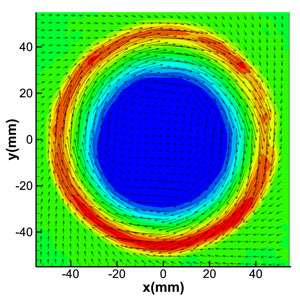Researchers explore advantages of ported shroud turbochargers

(Phys.org) —The federal government wants more fuel-efficient vehicles on the country's highways and back roads, which often comes at the cost of reduced engine size and power. That can be hard to reconcile with a population that tends to be fond of its muscle car history.
However, engineering research from the University of Cincinnati is helping an industry partner better understand how to give both groups what they want: smaller, more efficient engines that are capable of producing the same rubber-burning power.
California-based engine parts manufacturer Honeywell Turbo Technologies helps make mini but mighty motors with its ported shroud turbocharger technology. Ephraim Gutmark, the Ohio Regents Eminent Scholar Chaired Professor of Aerospace Engineering and Engineering Mechanics at UC, and doctoral student Matthieu Gancedo are helping Honeywell understand why its product works so well and how to improve its performance.
Gancedo and Gutmark's research, "Experimental Investigation of Flow Instability in a Turbocharger Ported Shroud Compressor," will be presented at the American Society of Mechanical Engineers International Gas Turbine Institute's Turbo Expo, held June 3-7 in San Antonio. The 58th annual event unites leading experts in the turbomachinery industry to share the latest innovations.
A turbocharger uses a compressor to pump pressurized air into an engine's combustion chamber, giving the engine a power boost. But that power has its limits.
"At a certain point, when you increase the pressure too much, the turbocharger becomes very unstable," Gutmark says. "It starts to go into vibration and making a lot of noise and not working."
The point where the turbocharger becomes unstable and no longer produces the increasing pressure that's required is called the "surge line." Honeywell's ported shroud recirculates excess airflow to push the surge line back, extending the turbocharger's effectiveness and the range of the engine's power.
Honeywell partnered with UC to take advantage of the university's advanced diagnostics capabilities. By using methods such as particle image velocimetry, researchers have for the first time been able to experimentally reconstruct three-dimensional maps of surge cycle aerodynamics. The measurements obtained provide insight into the ported shroud turbocharger performance.
"What we did was understand how the ported shroud turbocharger works and come up with recommendations on what changes will be needed for better performance," Gutmark says.
Building industry relationships founded on teamwork
Gutmark first began work on this project about five years ago when he visited Honeywell to demonstrate UC's expertise with other turbomachinery. When Honeywell expressed interest in partnering on the turbocharger project, Gutmark began work on upgrading UC's facilities. Now, Gutmark says his lab in Rhodes Hall is one of the few at an American university capable of performing the kind of complex diagnostics required for turbocharger analysis.
Gutmark says UC's unique combination of high-tech facilities and advanced research acumen makes the university an attractive and successful partner for industry. Over the years he's worked on a broad range of projects with companies from across the country – Boeing in Washington, Halliburton in Texas and General Electric in New York or here in Cincinnati.
"We have in our lab a very unique capability of providing support to industry in understanding basic phenomenon and developing new technology and applying very advanced diagnostics, experimentation and the computations to solve their problems and produce innovations that will lead them to new products," Gutmark says.
Gutmark also points to a three-pronged strategy that has helped enable him to enjoy such mutually beneficial collaborations with industry: treat industry as part of your team; adhere to the industry time line for each project; and show industry partners how your input contributes to their bottom line.
"Dealing with industry as a team, rather than two separate entities, that's a very important part of our success. We show them we can give them new ideas for new products. That contributes to their commercial success, and that brings more investment in the university," Gutmark says.
Provided by University of Cincinnati



















